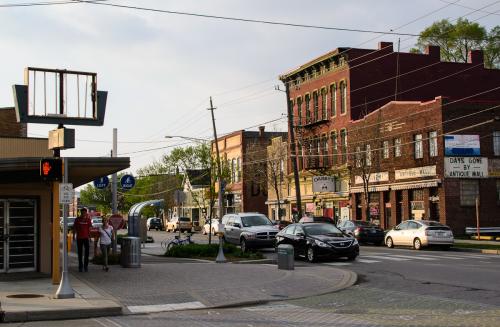Last year, voters in Indianapolis approved a ballot measure increasing their income taxes to expand the core county’s mass transit system, a notable development in this red-state capitol. The 25-member city-county council formalized the deal with its own bipartisan endorsement of the plan to connect 220,000 more residents by frequent bus service. Church groups, social justice advocates, and business and civic leaders made the case that the transit expansion was essential for boosting economic competitiveness, workers’ access to opportunity, and neighborhood revitalization. These were not separate arguments but a joint appeal, including the leading business chamber embracing the importance of closing the region’s economic and social disparities.
As Indianapolis transitions from an older industrial city with rising poverty to an emerging tech hub, the city showed it could bring together a diverse coalition of grasstops and grassroots leaders, around a common narrative, to address the challenges and opportunities in their region. And, crucially, this wasn’t a one-off collaboration: Indianapolis’ economic development leaders are continuing to emphasize inclusion and new partnerships as part of their approach to growth and competitiveness.
Business leaders and economic development groups across most regions have traditionally seen equity and opportunity as mission creep. But Indianapolis’ experience is emblematic of a growing awareness emerging in cities across the country that, facing widening disparities, a wider spectrum of leaders will need to commit to building broad-based prosperity.
This shift benefits growth actors and traditional equity advocates.
Economic inclusion, the evidence shows, makes solid business sense, in addition to serving a moral purpose.
Economic inclusion, the evidence shows, makes solid business sense, in addition to serving a moral purpose. At the same time, firms and the economic development community are essential to building a dynamic regional economy that generates middle-class jobs and expanding pathways to those jobs with customized training programs. They help set the agenda in regions, bringing networks and funding to key issues. For community developers, social service providers, and workforce leaders who have long worked with underserved populations, business leadership groups can bring new attention, resources, and partnership to a growing challenge.
How can cities build and sustain these new coalitions for inclusive growth? Working with Brookings, the Indy Chamber, along with the Nashville Area Chamber of Commerce and the San Diego Regional Economic Development Corporation, underwent a rigorous, eye-opening process earlier this year to explore their potential role. Here are three lessons from that work:
A new approach demands a new way of understanding. Inclusion is a value and a mindset, not simply a program. For economic development organizations typically tasked with positively selling their region, acknowledging serious challenges and the limits of current efforts is fundamental to shifting strategy. Developing a data-driven “narrative” about regional economic inclusion challenges helps build consensus around these issues and convince new audiences of the imperative to address inclusive growth. In one region, business leaders came to terms with the startling fact that half of families earn less than $50,000, leaving them stretched to cover basic expenses. In others, leaders acknowledged that low educational attainment among diverse youth, high housing and education costs, and long job commutes posed barriers to opportunity and threatened regional competitiveness.
No single organization can deliver change. To achieve more meaningful, community-wide progress, economic development organizations and others will need to step out of their comfort zones. Community development organizations and non-profits, who have long focused on serving the needs of individual neighborhoods and populations, will need to plug into broader jobs initiatives to inform, and benefit from, new economic plans and opportunities. Educators and skills providers can partner with employers to design industry-relevant talent initiatives that provide new opportunities for residents and help economic developers more effectively attract and retain employers. As trite as it sounds, regions will make greater progress if leaders in economic, workforce, and neighborhood development joined efforts more often around shared goals.
New awareness ultimately needs to be translated to action. Indianapolis’ transit coalition offers one example of how leaders can partner to advocate for shared goals. The Nashville Chamber is supporting an even larger bid to expand transit in that region. In San Diego, the City of San Diego, the community-based Jacobs Center for Neighborhood Innovation, and the region’s prominent CONNECT innovation organization are working together to locate an accelerator in the city’s Promise Zone. Other regions are also piloting approaches. A new initiative in Northeast Ohio, for instance, unites job creators, community developers, and regional planners to concentrate development and job growth around a series of regional “job hubs” with the goals of reducing transit barriers for workers, providing employers with a more consistent labor pool, and limiting the expansion of the region’s spatial footprint.
Only eight of the nation’s largest metropolitan areas are currently generating economic growth that improves the incomes and employment of whites and people of color. Increasing that number will require city leaders of all stripes reaching out across the aisle in new ways to address the most important issues facing cities today. An emerging group of leaders is defining a new type of regional coalition for inclusive growth. More will need to join them.
The San Diego Regional EDC is a member of the Metropolitan Leadership Council, a network of business, civic, and philanthropic leaders that acts as a financial and intellectual partner of the Brookings Metropolitan Policy Program.
The Brookings Institution is committed to quality, independence, and impact.
We are supported by a diverse array of funders. In line with our values and policies, each Brookings publication represents the sole views of its author(s).







Commentary
A new brand of inclusive growth coalitions
November 2, 2017